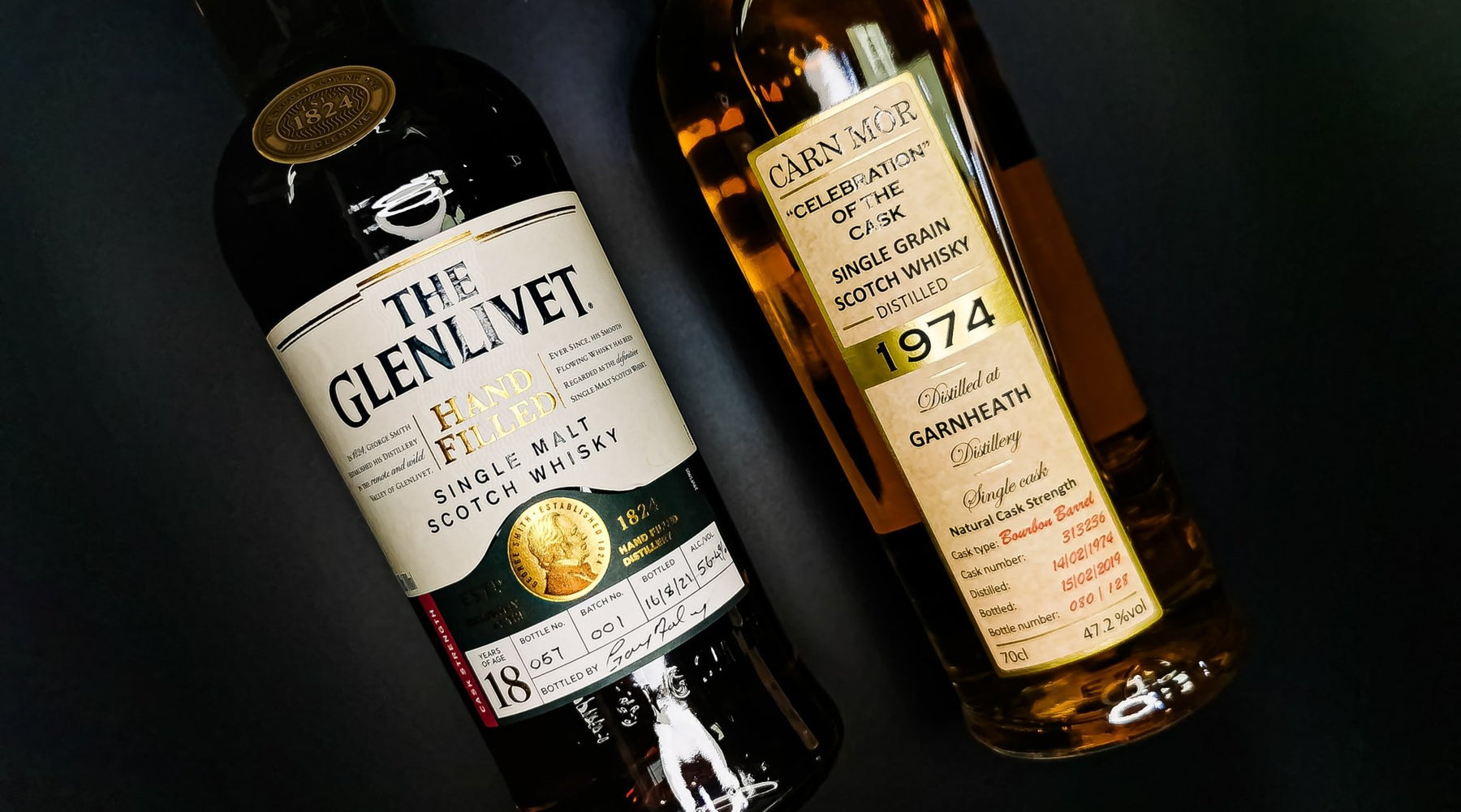
Malt Vs Grain: What's the Difference?
Single malt whisky is typically held to a higher standard in the whisky world. Even if you don’t really know anything about whisky, you might find yourself with the same opinion purely because that’s become the general consensus. However, you may be thinking this based on a few less than truthful facts. So, let’s take a look at these two types of whisky and really see what’s actually different between them.
So, what exactly is a single malt and a single grain?
Well, in order for a whisky to be classed as a single malt, it needs to meet a few requirements. Firstly, the ‘single’ element simply means that it was created in one distillery, even if it is a blend. Secondly, the ‘malt’ element tells us that the whisky was made from malted barley, and is the only grain to be used. Thirdly, single malt whiskies are made in pot stills exclusively.
A single grain whisky works the same way with it being made in one singular distillery. However, the difference comes with the grain aspect, with grain whiskies being made of multiple grains such as wheat, corn, and rye. They also use column stills instead of pot stills, even if a whisky is made from malted barley. If it’s made in a column, it’s a grain whisky.
I know what you’re thinking...how are they made?
There are 5 steps in the process of making single malt whisky; malting, mashing, fermentation, distillation, and maturation (lots of ‘ings’ and ‘tions’ basically). Malting is where the barley is steeped in water and then laid out to germinate on the malting floor for about a week. This allows the barley to sprout, in turn releasing specific enzymes and sugars that are needed for the second step: mashing. It’s at this point the wet barley (or malt) is placed in a kiln to dry, some distilleries like to add peat at this stage which is what gives some whiskies their smoky characteristics.
Once the malt is dried, it moves onto the next part of the process where it is ground up into a fine flour called grist, hence the name ‘mashing’. Hot water is added three times, with the temperature increasing each time from roughly 65° to 95°, so that the sugars can be fully extracted before it’s cooled and yeast added.
Now it’s time for the third stage; the first of the ‘tions’ - fermentation. The sugar and yeast mixture, known as wort, is stored for between two and four days to ferment in vats called wash backs. The yeast essentially feeds on the sugar and produces alcohol, which at this point is a mere 7-8% alcohol level. The product as a whole however is called a wash at this point. Next up is the stills where the wash is heated and distilled.
Distillation will typically happen in two rounds; the first happening in the wash still where the product reaches an alcohol level of around 20%, and the second happening in the spirit still where it will reach an alcohol level of around 65-70%. The amount of heat and the length of time can have an effect on the taste of the final whisky. Typically, a low and slow approach is the most welcomed as it produces the smoothest product, with a time range of 4-8 hours being the standard.
The fifth and final stage is maturation, where the wash, now known as the new-make spirit, is placed into oak casks. It is important that it is oak casks as this is one of the requirements to be known as a single malt, as well as it having to be matured in that cask for at least 3 years. Other than it being oak, there are no other requirements for the cask itself. It can be a former sherry or wine cask, each being a popular choice for the notes they lend to the whisky they mature. It is also at this stage where a whisky gets its signature amber colouring.
Producing grain whisky, for the most part, follows the same structure. It can include malted grains therefore can include the malting stage; however, this isn’t necessary like it is for single malts. The main difference is seen at the distillation stage as it uses a different type of still. A coffey, or column still is used in a continuous distilling process instead of using 2 pot stills in separate batches. A column still circulates the wash, warming and cooling it in order to extract the alcohol - Producing an alcohol level of up to 95%.
Yeah, but what about taste?
In terms of the flavour profiles, single malts tend to have a stronger flavour with notes of smoke, tobacco, and wood to name but a few. Meanwhile, grain whiskies have a lighter flavour; almost floral with hints or vanilla and honey. However, due to grain whisky being just that and made of various different grains, this can change the taste dramatically resulting in the wide selection that is on offer. They are also looked to more frequently for cocktail making because of their lighter, cleaner palette.
Overall, the main difference is that malt whisky is made from barley alone and grain whisky from multiple grains, alongside the different stills that are used in the distillation stage.
Fancy trying a single malt, or single grain? Or perhaps even both to see the difference for yourself? Here’s a couple of our favourites over here at Old & Rare...
Port Ellen 1982 Signatory Vintage 25 Year Old Scotch Whisky (Single Malt)
Glenlivet 18 Year Old Hand Filled Batch No.1 Single Malt Whisky 70cl, 56.4% ABV (Single Malt)
Cameronbridge 25 Year Old 1994 A.D.Rattray Single Grain Whisky 70cl, 58.1% ABV (Single Grain)
Carn Mor 1974 Celebration of the Cask Scotch Whisky, 70cl, 47.2% ABV (Single Grain)
